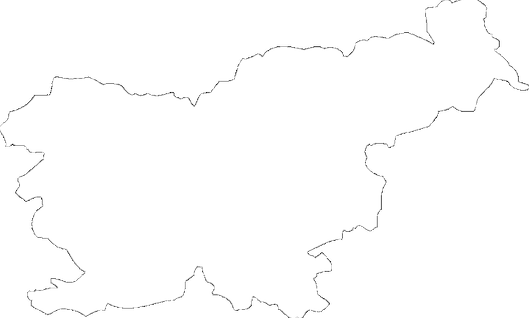EAT:
People from Slovenia’s northern neighbour Austria come to Slovenia just for the food; with a mixture of Subalpine, Italian, Hungarian and Balkan cuisine, most people will find something to their liking – unless they’re strict vegetarians. Many claim that the pizza here is as good or even better as in neighboring Italy.
Cuisine:
Generally speaking, Slovenian food is heavy, meaty and plain. A typical three-course meal starts with a soup (juha), often just beef (goveja) or chicken (piščančja) broth with egg noodles (rezanci), and then a meat dish served with potatoes (krompir) and a vinegary fresh salad (solata). Fresh bread (kruh) is often served on the side and is uniformly delicious.
Common mains include cutlets (zrezek), sausage (klobasa) and goulash (golaž), all usually prepared from pork (svinjina), lamb (jagnjetina) and game (divjačina), but there is a large choice of fish (ribe) and seafood even further away from the coast. Popular Italian imports include all sorts of pasta (testenine), pizza (pica), ravioli (ravioli) and risotto (rižota). A major event in the countryside still today is the slaughtering of a pig from which many various products are made: blood sausage (krvavica), roasts (pečenka), stuffed tripe (polnjeni vampi), smoked sausage (prekajena salama), salami (salama), ham (šunka) and bacon (slanina). Recipes for the preparation of poultry (perutnina), especially turkey (puran), goose (gos), duck (raca) and capon (kopun), have been preserved for many centuries. Chicken (piščanec) is also common. Squid is fairly common and reasonably priced.
Uniquely Slovenian dishes are available, but you won’t find them on every menu, so here are some to look out for:
- Kraški pršut – air-dried ham, similar to but not the same as Italian prosciutto
- štruklji – dumplings which Slovenians prepare in 70 different ways stuffed with sweet fillings, meat or vegetables
- žganci – a type of polenta (ajdovi žganci are made of buckwheat)
- žlikrofi – potato dumplings similar to gnocchi, specialty of the Idrija region
- jota – a type of soup made of beans, sauerkraut, potatoes, bacon, spare ribs, and the main seasoning is garlic.
Some Slovenian desserts can also be found:
- potica – a type of nut roll for holiday occasions also prepared with the widest variety of fillings.
- prekmurska gibanica – a very heavy cakelike pastry of poppy seeds, walnuts, apples, raisins, cheese etc.
Places to eat:
At the top of the food chain is the restavracija (restaurant), which could be a fancy restaurant with waiters and tablecloths or just a typical Chinese restaurant. More common in the countryside are the gostilna and gostišče, rustic inns serving hearty Slovene fare. Lunch sets (dnevno kosilo) cost around €7 for three courses (soup, salad and main) and the large portions are usually well worth the paltry cost.
Fast food is, invariably, cheap, greasy and (more often than not) terrible. It’s best to steer clear of the local mutation of the hamburger, which is served up in grills and snack bars known as okrepčevalnica. There is no real Slovenian fast food, but Slovenians have adopted greasy Balkan grills like pleskavica (a spiced-up hamburger patty) and čevapčiči (spicy meatballs) are ubiquitous, but one of the more tasty if not healthy options is the Bosnian speciality burek, a large, flaky pastry stuffed with either meat (mesni), cheese (sirni) or apple (jabolčni), often sold for as little as €2. Many fast food places make döner kebabs, and they are among the most popular fast foods in Slovenia. It’s very difficult to find a bad kebab in Slovenia, and they are sold in many places nationwide.
DRINK:
In proper Slovene style, all bases are covered for drinks and you can get very good Slovenian beers, wines and spirits. Tap water is generally drinkable.
Coffee and tea:
In Slovenia, coffee (kava) usually means an espresso, and cafes (kavarna) are a common sight with a basic cup costing €1.00-€1.50. One can also order coffee with milk (kava z mlekom) or whipped cream (kava s smetano). Coffee culture is widespread in Slovenia, and one can see Slovenes with friends sitting in the same café for hours. When invited to a cup of coffee at someone’s home, expect turkish coffee. Tea (čaj) is nowhere near as popular, and if they do drink it (mostly in the winter), Slovenes prefer all sorts of fruit-flavored and herbal teas over a basic black cup. Tea is served with honey and lemon by request.
Beer:
Beer (pivo) is the most popular tipple and the main brands are Laško and Union. Adam Ravbar beer is good quality and is usually hard to find anywhere except in their small brewery (located in Domžale, a town about 10 km north of Ljubljana). A bottle or jug will cost you €2.50 in a pub (pivnica). Ask for veliko (large) for 0.5L and malo (small) for 0.3L. Also try “Union Radler Grapefruit”, a refreshing mixture of beer and grapefruit juice.
Wine:
Despite what you might think if you’ve ever sampled an exported sickly sweet Riesling, Slovenian wine (vino) can be quite good — as in Germany, they keep the best stuff for themselves. Generally, the Goriška brda region produces the best reds and the drier whites (in a more Italian/French style), while the Štajerska region produces the best semi-dry to sweet whites, which cater more to the German/Austrian-type of palate. Other local specialities worth sampling are Teran, a very dry red from the Kras region, and Cviček, a red so dry and light it’s almost a rosé. Wine is usually priced and ordered by the decilitre (deci, pronounced “de-tsee”), with a deci around €1 and a normal glass containing about two deci.
Spirits:
A Slovene brandy known as žganje or (colloquially) šnops, not unlike the Hungarian palinka, can be distilled from almost any fruit. Medeno žganje also known as medica has been sweetened with honey. Vodka is, as in most of Slavic nations, also very popular, especially among the youger generation.









